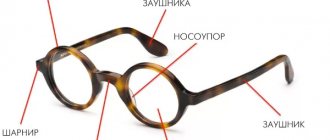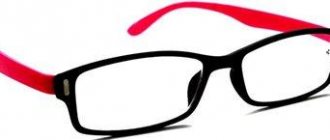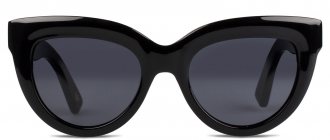What are sunglasses for?
The benefit of high-quality sunglasses is that they protect the visual organs from solar and ultraviolet radiation.
In this article
- What are sunglasses for?
- Who is recommended to wear sunglasses?
- What are the dangers of low-quality sunglasses?
- How to choose quality glasses by type of protection?
- Features of the material and color of sunglasses lenses
- Types of sunglass frames
- How to choose glasses taking into account your facial features?
Exposure to the sun's rays can cause serious damage to your eyes. If glasses do not block ultraviolet radiation, it gradually accumulates in the body and leads to the formation of a large number of free radicals. They destroy protein compounds and ribonucleic acids. The pathological process leads to ophthalmological disorders and decreased vision. The fact that sunglasses transmit ultraviolet radiation often results in:
- “dry eye” syndrome: exposure to harmful radiation reduces the amount of tear fluid, which causes burning and itching;
- pterygium - damage to the cornea by altered tissues of the conjunctiva, which occurs in the area of the limbal ring and grows to the center of the cornea;
- photokeratitis - a form of burn of the cornea, accompanied by redness of the protein membrane, tearing, sensation of a foreign body in the eye;
- pinguecula is a pathology in which small yellow formations appear in the nasal region of the conjunctiva;
- cataract - clouding of the lens due to exposure to harmful ultraviolet rays;
- solar retinopathy, in which the process of destruction of neurosensory cells occurs in the central part of the retina.
The lens that suffers most from exposure to ultraviolet radiation is the lens, a natural filter for ultraviolet radiation. It almost completely absorbs light rays whose length ranges from 315 to 400 nm (nanometers). Because of this, the protein compounds of the lens are destroyed, and the structure of the elements of the visual apparatus changes.
Children more often than adults suffer from exposure to ultraviolet rays, since at a younger age the visual organs cope less well with external loads on the eyes. The consequence of this is a decrease in the elasticity of the lens, which often leads to the development of farsightedness in children.
conclusions
How to avoid mistakes when buying glasses
Now you know everything about how to choose high-quality sunglasses for women, men and children, where is the best place to shop and what nuances there may be when choosing. Take care of your eyesight, don’t wear the accessory unless necessary, and remember – cheap glasses can be too expensive.
Who is recommended to wear sunglasses?
Everyone, without exception, should wear sunglasses. There is a certain category of people for whom choosing sunglasses is not advisable, but mandatory. Ophthalmologists recommend wearing sunglasses for people who regularly take diuretics and tranquilizers. The components that make up these medications increase the sensitivity of the eyes to light and reduce the blocking properties of the lens. For such people, these ophthalmic products are not a stylish accessory, but necessary eye protection. This also applies to:
- residents of sunny regions;
- owners of light tones of the iris;
- people who have undergone cataract surgery;
- patients who have undergone a therapeutic photodynamic course;
- athletes who spend a lot of time in the sun;
- solarium visitors.
The sun's rays are dangerous not only in summer, but also in winter. Many people do not know about this, so they think that it is worth buying glasses only for the warm season. Doctors note that the winter sun is just as dangerous as the summer sun. Snow cover, ice surface, and wet road surfaces reflect ultraviolet radiation, which means that even in the cold season you should choose sunglasses.
Cloudy weather is not a reason to leave your sunglasses at home. Clouds transmit mid-wave rays, which are dangerous for the visual organs. Because of this, your health often worsens, headaches occur, and your eyes water.
What are the dangers of low-quality sunglasses?
Budget sunglasses do not provide good UV protection. When it darkens, the pupils dilate. If at this moment you have a cheap model of sunglasses on your eyes, this will lead to harmful exposure to ultraviolet rays. Its first symptoms: discomfort in the visual organs, lacrimation, the appearance of spots and “floaters” before the eyes. If a person has been using budget models for many years, sooner or later he runs the risk of encountering one of the ophthalmic pathologies that develop due to increased sensitivity to light rays. Doctors advise choosing sunglasses with polarized coating. Such models protect the eyes from sunlight and ultraviolet rays, as well as from glare that is formed when light is reflected from horizontal surfaces. Polarized lenses have several layers, in the center of which there is a transparent film. It blocks ultraviolet rays. Manufacturers of cheap sunglasses only stick the film on one side. Because of this, the level of protection is incomplete. Over time, the film wears off, so low-quality models become not only useless, but also dangerous for the eyes.
Cheap sunglasses only reduce light intensity. They do not block glare, so they have a negative effect on human eyes. To prevent this, some manufacturers apply one of the protective coatings to the lenses. Most often - anti-reflective and photochromic. Such sunglasses transmit less ultraviolet rays to the cornea, but they cannot replace a polarizing filter. High-quality models transmit no more than 50% of the sun's rays and block glare that is reflected from horizontal surfaces. Often these glasses are chosen by drivers, athletes and outdoor enthusiasts.
Degrees of light transmission
There are generally accepted 5 categories of light transmission in the visible part of the spectrum (protection), into which all sunglasses are divided (not to be confused with ultraviolet protection):
- 80-100% (transparent) – for indoors, twilight and night wear. Used as protection against snow and wind.
- 43-80% – for cloudy weather and as an image accessory.
- 18-43% – for wearing in the city and driving a car.
- 8-18% – protection from bright daytime sun.
- 3-8% – protection for high mountains, ski resorts, and the Arctic. Not intended for normal urban use.
- Less than 3% (out of categories) – for protection against welding.
The degree of light transmission partially protects from ultraviolet radiation, the main purpose is protection from glare and squinting. You can understand the degree of light transmission by trying on glasses; the designations will be unnecessary. But with the degree of protection from ultraviolet radiation everything is more serious.
How to choose quality glasses by type of protection?
There are several types of solar radiation. They differ in the nature of their occurrence and the degree of impact on the human visual organs. About 40% of radiation is classified as visible. It helps distinguish the colors of the spectrum and is not harmful to the eyes. Approximately 50% of the sun's rays are infrared. They are necessary so that a person can feel warmth. The remaining 10% of radiation is ultraviolet, which is invisible to the eye. Depending on the wavelength, solar radiation is divided into several categories, which have the following designations:
- UVA - long wavelength;
- UVB - mid-wave;
- UVC - short wave.
The most dangerous radiation is long-wave radiation. Its range is from 315 to 400 nm. It actively affects the lens, causing it to lose transparency and acquire a yellowish tint. This often causes the development of cataracts. Medium wave radiation is less dangerous. It is in the range from 280 to 315 nm. Only a small fraction of it reaches the Earth's surface. Medium wave radiation is absorbed by the cornea of the eye. This leads to loss of optical properties. The safest is short-wave radiation, which ranges from 100 to 280 nm. Most of it is retained by the ozone layer.
Sunglasses made from high-quality materials have a special marking - an indicator of protection. The highest quality products have a UV 400 mark.
These sunglasses block up to 99% of long-wave radiation. They have one drawback. Wearing these sunglasses continuously may cause white spots to form around the eyes. They arise because the skin in this area does not tan. A more popular model is labeled UV 380. Such ophthalmic products block up to 95% of harmful rays. You should not buy glasses that transmit more than 50% of ultraviolet radiation. These models provide minimal protection.
Features of the material and color of sunglasses lenses
Lenses are an important component of any ophthalmic product. Many buyers opt for glass lenses, believing that they are of higher quality and better block ultraviolet radiation. The main advantages of glass lenses:
- scratch resistance;
- high optical properties;
- abrasion resistance.
When buying sunglasses, you should pay attention that glass lenses only partially block ultraviolet radiation. Their polymer analogues cope much better with this. Plastic lenses prevent rays A and B, whose wavelength ranges from 280 to 400 nm, from reaching the retina. Infrared radiation is best blocked by polarized sunglasses. Acrylic and polycarbonate are the high-quality plastics that manufacturers most often use to create sunglasses. These materials have many advantages, and their use makes it possible to make plastic ophthalmic products cheaper than glass ones. The advantages of polymer lenses include:
- light weight;
- eye safety;
- high protective properties.
Polymer lenses are recommended for children to wear, as they are highly impact resistant. They can be scratched, but are difficult to break, and therefore they are less dangerous. Even if the sunglasses are damaged, they will not harm the child's eyes. Such lenses are perfect for the production of sports and driving sunglasses.
When choosing sunglasses for yourself, you should also take into account the color of the lenses. It should be uniform. Lens shading should be applied with equal intensity over the entire area. You should not choose glasses that are darkened only in the upper part. Such models may not absorb ultraviolet radiation well enough. This will lead to rapid eye fatigue. Many people tend to choose sunglasses with dark lenses. It is worth considering that intense black, brown or dark gray coloring does not provide maximum sun protection. If you choose sunglasses at a low price, the dark color of the lenses may be harmful to your eyes. This is due to the fact that under dark lenses the pupils dilate and the visual organs absorb more ultraviolet radiation. The best option is sunglasses with gray and green lenses. They provide accurate color reproduction and block UV rays well. For a trip to the sea or to the mountains, it is better to choose polarized sunglasses that protect the retina from ultraviolet radiation and glare. For cloudy days, it is recommended to choose golden yellow glasses that absorb blue light well.
For example…
- CR-39 (approx. - Columbia Resin No. 39) . Organic glass dates back to 1940. It is softer than glass and requires additional protection; it breaks easily.
- Polycarbonate (approx. Lexan, Merlon) . Created in 1953, this “plastic metal” is lightweight, more durable and safer than glass. Absorbs almost all UV rays and does not require additional lens processing.
- Trivex . The material appeared in 2000. It is shock-resistant, lightweight, and reliably blocks UV rays.
Types of sunglass frames
Optical stores offer a huge range of frames made of any materials. The most popular are plastic frames. They are made from cellulose acetate, grilamid, nylon, optyl and other materials. They are easy to process. Frames of any design can be made from plastic. It is easiest to choose such sunglasses, since they are available from any manufacturer. Plastic transmits a small amount of sunlight, it is strong and durable. You can choose sunglasses with metal frames. Titanium, aluminum, and Monel, an alloy of nickel and copper, are usually used for its production. Sometimes they have wooden inserts and look very stylish.
Before purchasing sunglasses, experts recommend carefully examining and trying on ophthalmic products. You can open the temples several times and bend them slightly. High-quality models are resilient and elastic. They hold their original shape well. The screws that secure the temples must be strong. If the frame is small, the temples will diverge. They can put pressure and quickly become unusable. If the frames are too large, a gap will form between your face and the side of the glasses. Quality sunglasses have frame sizes indicated on the temple. You also need to pay attention to the nose pads. When wearing glasses, there should be no gap between the frame and the nose.
Fantasy details
Frames with decorative details are an option for those who have already found their “same” basic model and are ready to experiment. Famous fans of fantasy include Dolce&Gabbana and Gucci. Designers often present in their collections glasses with fancy temples, original prints and a scattering of rhinestones.
The main trend of recent seasons has been glasses on a chain. Whether it's a thin string of pearls or a version with large plastic links, this accessory has forever lost its old-fashioned connotations and is loved by many for its practicality. While the glasses are hanging on your neck, the risk of losing or breaking your favorite pair tends to zero.
FRAME CHAIN Loop De Loop gold-plated glasses chain
Buy
MIU MIU Oversized crystal-embellished square-frame acetate and silver-tone sunglasses
Buy
FRAME CHAIN Pearly Queen pearl and gold-plated glasses chain
Buy
GUCCI Crystal round metal sunglasses
Buy
How to choose glasses taking into account your facial features?
For many people, sunglasses are a beautiful accessory, so it is recommended to buy them based on your face shape. Those with a square face shape should choose massive frames. If the frame is rimmed, then it is better to choose dark or bright shades. Both aviator and butterfly glasses will look good on a square face. Such models help smooth out the geometry of the lower jaw and the angularity of the forehead. It is not recommended to buy square and rectangular frames, as they highlight imperfections in your face shape. For those with a round face shape, glasses with wide temples are perfect. The right choice would be models with pointed shapes that direct the gaze to the temple, elongating the face. It is recommended to choose cat eye glasses. Rectangular models will look good. It is better to avoid dark shades of frames. Preference should be given to pastel colors: soft pink, peach, lilac, mother-of-pearl. The combination of these rules will help visually lengthen your face. Tishaids are not suitable for those with round faces.
High cheekbones and a sharp chin are the hallmarks of a heart-shaped face. The main rule to follow when choosing sunglasses is to try to balance the heavy upper part of the face and the narrow lower part. Cat-eye or grand glasses, which have large lenses and plastic frames, are ideal. It is better not to choose thin frames. Models in which the upper part of the frame is more pronounced than the lower will look good. You can pick up Clubmaster sunglasses.
Those with an oval face shape are the luckiest. Many of them know very well how to choose sunglasses. Absolutely any model is suitable for such people: square, rectangular, “cat’s eye”, “butterfly”, clubmaster, “wayfarer” and others. The oval face shape is proportional and has soft contours. The ideal solution for its owners would be aviators with dark, gradient or mirror lenses.
"Butterflies"
This season, narrow models in the style of the Matrix characters have been replaced by glasses that cover half of the face. In metal or large horn frames, “butterflies” appeared in the collections of Fendi and Chloé, and then quickly rose to the pedestal among summer accessories. Glasses of this format are considered quite universal and fit well not only with different styles of clothing, but also with most face shapes. “Butterflies” will beautifully highlight the cheekbones, accentuate the lips and reliably protect from the bright city sun.
ZIMMERMANN Aurora sunglasses
Buy
FENDI Oversized square-frame acetate and gold-tone sunglasses
Buy
CELINE EYEWEAR Butterfly acetate sunglasses
Buy
STELLA MCCARTNEY Square sunglasses
Buy
FENDI Oversized square tortoiseshell-acetate sunglasses
Buy











